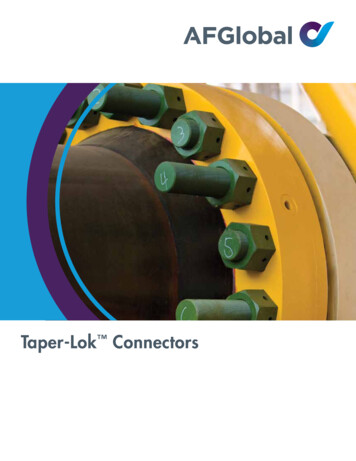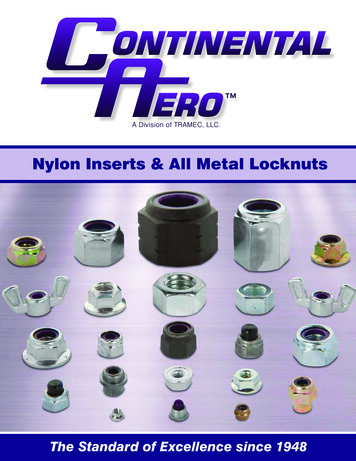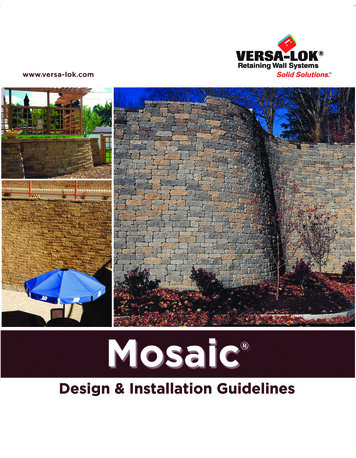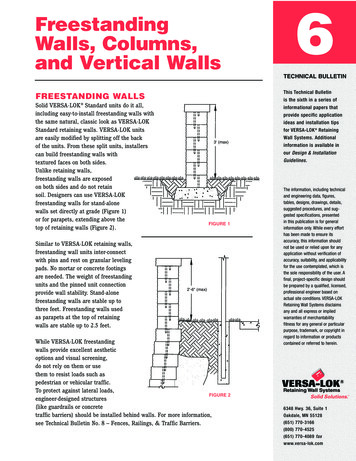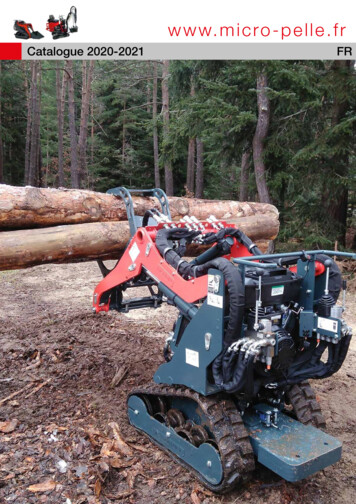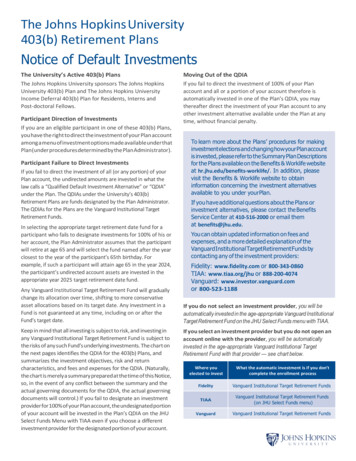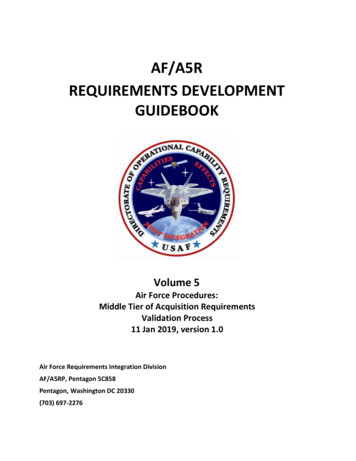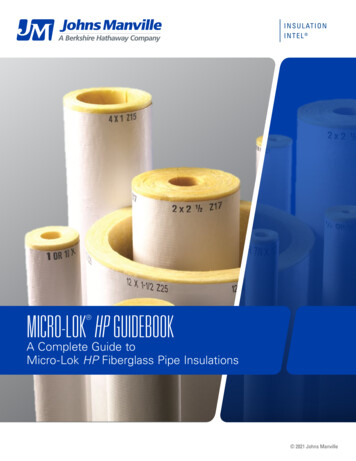
Transcription
MICRO-LOK HP GUIDEBOOK A Complete Guide toMicro-Lok HP Fiberglass Pipe Insulations 2021 Johns Manville
TABLE OF CONTENTSCHAPTER 1: PRODUCT DESCRIPTION AND sQualifications for UseApplication Recommendations: ASJ SSL Jacket & Butt Strips334455CHAPTER 2: SPECIFICATION DATA6CHAPTER 3: INSULSPEC – CSI al RequirementsQuality AssuranceDelivery, Storage and HandlingManufacturersPipe InsulationMaterialsExaminationInstallation – Chilled Water and Dual-Cycle System InsulationsInstallation – Above Ambient ConditionsField Quality Control888889991011111213CHAPTER 4: INSTALLATION METHODS14CHAPTER 5: THICKNESS RECOMMENDATIONS15Cold ApplicationsHot and Cold Applications1516CHAPTER 6: Heat Transfer Tables17CHAPTER 7: Nesting Charts34MICRO-LOK HP 2
CHAPTER 1: PRODUCT DESCRIPTION AND BENEFITSDESCRIPTIONThe Micro-Lok HP family includes three products.Micro-Lok HPFiberglass pipe insulation with an AllService Jacket (ASJ)Micro-Lok HP UltraFiberglass pipe insulation with apolypropylene-coated ASJMicro-Lok HP PlainFiberglass pipe insulation withoutany jacketingThe fiberglass used in Micro-Lok HP products is a rigid, one-piece insulation that offers superior insulatingcapabilities in applications ranging from 0 F to 850 F (-17.8 C to 454 C). It is made from glass fibers bonded witha thermosetting resin.The Micro-Lok HP product line is easily installed and damage-resistant, with high thermal efficiency and exceptionalsound absorption properties. In the manufacturing process, 3-foot (0.92 m) sections of Micro-Lok HP fiberglass pipeinsulation are cylindrically formed in one piece, then cut longitudinally through one wall and partially through theother. The result is a one-piece “hinged” construction that opens easily and closes firmly and uniformly along the pipe.In addition to simplifying the installation process, the one-piece design used in Micro-Lok HP fiberglass pipe insulationincreases thermal effectiveness by creating only one longitudinal joint.Micro-Lok HP fiberglass pipe insulation is produced in 3-foot (0.92 m) sections for Iron Pipe Sizes (IPS) 1 2” through 24”(13 mm through 610 mm), and Copper Tubing Sizes (CTS) from 5 8” through 6 1 8” (16 mm through 156 mm), dependingon insulation thickness. Micro-Lok HP & Micro-Lok HP Ultra pipe comes in insulation wall thicknesses of 1/2” - 5” in1/2” increments.Zeston PVC fitting covers and jacketing are specifically designed to be used with Micro-Lok HP fiberglass pipeinsulations. Ideal applications for combining Zeston PVC products with Micro-Lok HP fiberglass pipe insulation includechilled water piping, pipe systems that must meet USDA or FDA requirements, and exposed interior or exterior piping.JACKETINGThe jacketing systems on Micro-Lok HP and HP Ultra serve two purposes, first isas a vapor retarder. The ASJ and Ultra jacket have vapor retarder perm ratingsthat are robust enough to be used on chilled water systems. The second use fora jacket is for aesthetic applications. The neutral white finish of the insulationoften matches walls and ceilings when the pipe system is left exposed. Bothjacketing systems are secured with a Self-Sealing Lap (SSL) closure system. TheSSL is adhered with a strong acrylic adhesive that permits installation in coldweather conditions down to 20 F (-7 C), and it will not soften or separate whenMICRO-LOK HP 3
CHAPTER 1: PRODUCT DESCRIPTION AND BENEFITSheat and humidity are high. The adhesive is protected by a strip of easy-lift release paper with a “dry edge” to permit easyremoval during installation. Matching pressure-sensitive tape butt strips, using the same adhesive and a quick release paperstrip, are supplied in order to totally seal and secure the system, thus eliminating the need for staples.Micro-Lok HP: All-Service Jacket (ASJ) with a Self-Sealing Lap (SSL) Closure SystemThe Micro-Lok HP fiberglass pipe insulation jacket is a high-density, white kraft paper bonded to an aluminum foil,reinforced with fiberglass yarn. The kraft paper is chemically treated to enhance fire safety. The ASJ jacket has amoisture vapor permeance rating of 0.02 perms (per ASTM C1136), making it usable in chilled water applications.Additionally, the longitudinal lap of the jacket is secured with an SSL.Micro-Lok HP Ultra: Polypropylene-coated (Poly-top) All-Service Jacket with SSL Closure SystemThe Micro-Lok HP Ultra jacket offers better moisture resistance than the uncoated kraft paper facing of the ASJjacket. The poly-top coating gives the jacketing on Micro-Lok HP Ultra a moisture vapor permeance rating of 0.01 perms (per ASTM C1136). While weather-protective jacketing is required for outdoor applications, the additionof a poly-top Ultra jacket can also resist temporary exposure to small amounts of moisture as long as the exposedfiberglass ends have been vapor-sealed. This may potentially allow contractors to install the insulation earlier ona jobsite – before the building envelope has been enclosed. Micro-Lok HP Ultra’s jacket is cleanable by wiping itdown using a soft, damp cloth.APPLICATIONSMicro-Lok HP fiberglass pipe insulation products are suitable for heating applications up to 850 F (454 C) (see“Qualifications for Use”). This product family is designed for use on commercial, power or process lines where firesafety and a clean, aesthetic appearance are desired. Micro-Lok HP and Micro-Lok HP Ultra pipe insulations can alsobe used on cold and chilled water lines, brine pipelines, refrigerant and special process lines when specifiers haveensured sufficient insulation thickness to prevent condensation from forming on the insulation surface and when thejoints are sealed to prevent moisture migration. Metal or Zeston PVC jacketing can serve as a weather-protectivejacket for outdoor applications that use Micro-Lok HP products. This jacketing can also help protect against abuseprone environments when the insulation is installed in high traffic areas.ADVANTAGESHigh Insulating Efficiency. Micro-LokHP insulation offers high insulatingefficiency for pipe applications. For thethermal conductivity performance curve,refer to graph of “k” factors on page 6.Economical to Apply. Micro-Lok HPis light weight, and easy to install,leading to faster installation and lowerinstallation costs than many productsused in similar applications. Its simpledesign enables installers to easilyfabricate pieces during installation,and the one-piece construction speedson-the-job handling and application.The “dry edge,” easy-lift release stripon the SSL makes application simple,even with gloves on.MICRO-LOK HP 4
CHAPTER 1: PRODUCT DESCRIPTION AND BENEFITSSome of the advantages of Micro-Lok HP fiberglass pipe insulation that make these cost savings possible are:1. One-piece construction with full-length “spring hinge” opening helps speed jobsite installation.2. For indoor applications, a factory-applied jacket speeds installation and eliminates the need for an extra jacketing step.3. Micro-Lok HP fiberglass pipe insulation has a unique fiber network pattern that allows for precise and quickfabrication on the job.4. Micro-Lok HP fiberglass pipe insulation is light weight and easy to handle. Only three carton sizes are required tohandle most pipe sizes and thicknesses.25/50 Rating. Micro-Lok HP fiberglass pipe insulation with Zeston PVC fitting covers or metal jacketing provide acomplete, integrated system with all components rated for 25 flame spread and 50 smoke developed (25/50) perASTM E84. Micro-Lok HP is 25/50 UL listed and labeled over plastic pipe assemblies for air plenum applications whenused at 1.0” thickness or greater.QUALIFICATIONS FOR USEWhen using Micro-Lok HP or Micro-Lok HP Ultra, system designers need tobe careful to specify the appropriate insulation thickness for above and belowambient applications. In high temperature applications, the insulation shouldbe thick enough to keep the maximum surface temperature of the insulationbelow 150 F (66 C).During initial heat-up to operating temperatures above 350 F (177 C), anacrid odor and some smoke may be given off as the organic binders usedin the fiberglass pipe insulation begin to decompose. When this occurs,caution should be exercised to ventilate the area well. This loss of binderdoes not directly affect the thermal performance of the pipe insulation, butit can reduce the compressive strength and resiliency of the product. Forapplications with excessive physical abuse or vibration at high temperatures,consult Johns Manville for alternate material recommendations.APPLICATION RECOMMENDATIONS: ASJ SSL JACKET AND BUTT STRIPS1. Do not apply Micro-Lok HP fiberglass pipe insulation if air temperature is below 20 F (-7 C) or above 130 F (54 C) as the tapeadhesion during installation can be negatively impacted by the ambient air temperature. When applications fall outside thistemperature range, stapling is recommended. If stapling is required, it is recommended that mastic is applied over staples toprevent moisture penetration.2. If stored below 20 F (-7 C) or above 130 F (54 C), insulation cartons should stand within the recommended temperaturerange for 24 hours prior to application.3. Once the release paper is removed, the lap should be sealed immediately. Installers should take care to ensure both thejacketing and lap adhesive are kept free of dirt and water prior to sealing the lap.4. When adhered, the lap and butt strips must be pressurized by rubbing firmly with a plastic squeegee or the back of a knifeblade to ensure positive closure.5. Do not reseal the lap or butt strip once applied. This could compromise the quality of the sealed jacket system.MICRO-LOK HP 5
CHAPTER 2: SPECIFICATION DATASurface Burning CharacteristicsLimited CombustibilityJacketingWater Vapor Permeance(ASTM E96 – Procedure A)Burst Strength (ASTM D774)Tensile Strength (ASTM D828)0 F to 850 F (-18 C to 454 C) 5% by weight 5 ppm chloride standardNoneDoes not promote microbialgrowthComposite FHC 25/50 perASTM E84, NFPA 255, CAN/ULC S102.2NFPA 90A and 90BASTM C1136 (Type I & II)0.02 perms max. 55 lbs/in (4.6 Kg/cm )45 lbs./in. (7.9N/mm) width min.(MD)30 lbs./in. (5.23N/mm) widthmin. (CD)22Retested0.7.1000.6.0860.50.40.3.057Micro-Lok HP0.2Mean 0Temperature -18.072ASTM C 54710038Mean F75Temperature C24Btu in/(hr ft2 F)0.23W/m C 0.03420093100380.240.035300149.043W/m CService Temp. Range (ASTM C411)Moisture SorptionCorrosivity (ASTM C1617)Shrinkage (ASTM C356)Microbial Growth (ASTM C1338)THERMAL CONDUCTIVITY (“K”) *Conductivity ("k")Btu in/(hr ft2 F)PHYSICAL PROPERTIES.029400 500 ( F)204 260 ( 600.550.079* Apparent thermal conductivity values are determined by applying procedures dictated per ASTM C1045 ontest data obtained using ASTM Test Method C335. All values are based on nominal manufacturing and testingparameters, are subject to normal variation, and are not guaranteed for specification purposes or otherwise.SPECIFICATION COMPLIANCE ASTM C547 Type I (Replaces HH-I-558B, Form D, Type III, Class 12, Class 13 up to 850 F [454 C]) ASTM C585 – Dimension Standard ASTM C1136 (Jacketing) (Replaces HH-B-100B, Type I & II) MIL-DTL-32585 Type 1, Form 4, Facing A (unjacketed only) MIL-I-22344D, MIL-PRF-22344E Coast Guard/IMO Approved 164.109/56/0 (plain, unjacketed only – excluding 7/8 x ½ [22 mm x 13 mm], ½ x ½ [13 mm x 13 mm]) Bureau of Household Goods and Services CA-T1039 (CO) Firestop Assemblies: Meets requirement for jacketed fiberglass pipe insulation product density at or above 3.5 pcf. ASTM E84, CAN ULC S102.2 – 25/50 listed and labeled Intertek testing laboratories, listed and labeled Underwriter Laboratories NRC 1.36, ASTM C795, MIL-I-24244C, MIL-DTL-24244D**When ordering material to comply with these specifications a statement of that fact must appear on the purchase order. Specific lot testing will be conducted and a certification of compliance can be provided.Operating Temperature Limits: 0 F to 850 F (-18 C to 454 C)SUSTAINABLE BUILDING ATTRIBUTESDefiance, Ohio (43512)Manufacturing LocationRecycled Content (glass only) 41%28%Recycled Content (totalproduct)0.22 g/lVolatile Organic Compounds Total(ASTM D5116)(Analysis ASTM D6196& ASTM D5197)Formaldehyde 0.009 ppmFiberglass Pipe InsulationAldehydes0.043 ppm 49 g/lVolatile Organic Compounds Total(Calculated)Self-Sealing Lap & Butt StripsSUSTAINABLE BUILDING CERTIFICATIONSGREENGUARD GREENGUARD GOLDLEED CreditsLEED-NCCertifiedCertifiedTo see LEED info calltechnical supportAVERAGE 10% RECYCLED CONTENTPOST-CONSUMERInsulated Plastic PipeAssemblies (BSMP)MICRO-LOK HP 6
CHAPTER 2: SPECIFICATION DATAThe maximum use temperature of an insulating material is that temperature above which it no longer provides satisfactoryor effective service as a thermal insulation, when applied under conditions of normal usage. A normal condition implies anondestructive atmosphere, moderate applied loads, limited vibration and moderate thermal stresses.No single test for determining the maximum use temperature is applicable to all types of insulation or even to any onetype of insulation under all possible conditions of use.Johns Manville uses the following ASTM Test Procedures as guidelines in the evaluation of Micro-Lok HP fiberglass pipeinsulation and in the determination of the recommended maximum use temperature:ASTM C 335. Thermal conductivity of pipe insulation.ASTM C 356. Linear shrinkage of preformed, high temperature thermal insulation subjected to soaking heat. Micro-Lok HPfiberglass pipe insulation shows negligible linear shrinkage and/or warpage after the test period, with the loss in weightnot exceeding 10 percent when exposed to the test temperature.ASTM C 411. Hot surface performance of high temperature thermal insulation. Micro-Lok HP fiberglass pipe insulationdoes not flame, glow, smolder, crack, delaminate or warp after 96-hr. exposure to the heated surface. The fiberglass pipeinsulation can produce smoke and/or produce an acrid odor during initial heat-up.The following ASTM Test Procedures are used as guidelines in the production of Micro-Lok HP fiberglass pipe insulation.ASTM C 585. Inner and outer diameters of rigid thermal insulation, for nominal sizes of pipe andtubing (NPS System). Micro-Lok HP fiberglass pipe insulation is produced in standard sizes in order to facilitate doublelayer nesting applications or retrofit at a later date. This practice provides that the inner diameter of any section ofinsulation is consistent with the outer diameter of pipes and tubes.ASTM E 84. Surface Burning Characteristics of building materials. Micro-Lok HP fiberglass pipe insulation has a maximumflame spread rating of 25, maximum smoke developed rating of 50, representing an FHC 25/50.ASTM C 547. Standard specification for mineral fiber, preformed pipe insulation. Type I is for use up to 850 F (454 C).ASTM C 1136. Standard specification for flexible, low permeance vapor retarders (jacketing) for thermal insulation.ASTM C 1338. Standard test method for determining fungi resistance of insulation materials and facings.MICRO-LOK HP 7
CHAPTER 3: INSULSPEC – CSI SPECIFICATIONTMSECTION 220700 - PLUMBING PIPING INSULATIONSECTION 230700 - HVAC PIPING INSULATIONPART 1 – GENERALSCOPEA. The work covered by this specification consists of furnishing all labor, equipment, materials and accessories, andperforming all operations required for the correct installation of Micro-Lok HP fiberglass pipe insulation on allchilled water and dual-cycle pipe systems, fittings, valves, controls and all other necessary items connected intothe system subject to condensation or loss of heat when using JM Micro-Lok HP fiberglass pipe insulation.REFERENCESA. ASTM C547 Specification for Mineral Fiber Pipe Insulation.B. NFPA 90A Standard for the Installation of Air-Conditioning and Ventilating Systems.C. ASTM C585 Practice for Inner and Outer Diameter of Rigid Thermal Insulation for Nominal Sizes of Pipe and Tubing(NPS System).D. ASTM C795 Specification for Thermal Insulation for Use in Contact with Austenitic Stainless Steel.E. ASTM C1136 Specification for Flexible, Low Permeance vapor retarders for Thermal Insulation.F. ASTM E84 or CAN ULC S102 for Surface Burning Characteristics of Building Materials.G. MIL-I-24244 Military Specification Insulation Material with Special Corrosion, Chloride and Fluoride Requirements.H. NRC 1.36 Nonmetallic Thermal Insulation for Austenitic Stainless Steel.I. NFPA 259 Standard Test Method for Potential Heat of Building Materials.J. ASTM C 1729 Standard Specification for Aluminum Jacketing for InsulationK. ASTM C 1767 Standard Specification for Stainless Steel Jacketing for InsulationSUBMITTALSA. A. Product Data: Provide product description, list of materials and thickness for each service or equipmentscheduled, locations and manufacturer’s installation instructions.B. Shop Drawings: Submit list of insulation material and thickness to be used for each service. Include installationdetails for valves, fittings, pipe and all other items to be insulated.C. Samples: Submit samples of each insulation system to be used.ENVIRONMENTAL REQUIREMENTSA. Maintain ambient temperatures and conditions required by manufacturers of adhesives, mastics and insulatingcements.QUALITY ASSURANCEA. Insulation Materials: Fiberglass insulation materials must be manufactured at facilities certified and registered withan approved registrar to conform to ISO 9001 Quality Standard.1. Pipe insulation shall be pre-formed and furnished in standard lengths with ends cut square, conforming withdimensional requirements of ASTM C585.2. Insulation materials shall be asbestos free.3. All insulating products shall have a 25 or less flame spread index and 50 or less smoke developed index ratingas tested in accordance with ASTM E84.MICRO-LOK HP 8
CHAPTER 3: INSULSPEC – CSI SPECIFICATIONB. Workmanship: Where available, all insulation to be installed by a licensed and experienced applicator. Materialsshall be applied in accordance with the manufacturer’s recommendations.1. All work shall comply with all applicable federal, state and local codes and laws. This shall include, but shallnot be limited to, the Occupational Safety and Health Act.2. All work shall conform with accepted industry and trade standards for commercial and industrial insulations.Where available, it is recommended to use a National Insulation Association (NIA) certified (or other similarlycertified) mechanical insulation inspector throughout the project to inspect and verify the materials and totalinsulation system have been installed correctly in accordance with the Johns Manville guide specifications.3. Surfaces to be insulated shall be clean and free of dirt, scale, moisture, corrosion, and oil and grease.C. Insulation materials that have become wet or contaminated shall not be installed.DELIVERY, STORAGE AND HANDLINGA. Deliver all materials (insulation, coverings, tapes, cements, adhesives, jacketing, coatings, etc.) to the job sitein factory containers with manufacturer’s label showing manufacturer, product name and where applicable, theASTM E84 performance information. For all materials that list fire hazard information, technical data sheets shallbe provided.B. Protect insulation from dirt, water, chemical attack and mechanical damage before, during, and after installation.C. Installed insulation that has not been weatherproofed and that is not protected by roof and walls shall be protectedfrom precipitation by waterproof sheeting installed by the contractor. Wet or damaged insulation shall not beinstalled and, if installed, shall be removed and replaced by the contractor at no additional cost.PART 2 – PRODUCTSMANUFACTURERSA. Pre-formed fiberglass pipe insulation: Johns Manville’s Micro-Lok HP or Micro-Lok HP Ultra with all servicevapor retarder jacket (ASJ), with white kraft paper or poly-exterior surface, a self-sealing longitudinal closure lap(SSL), and butt strips or approved alternate.B. PVC insulation jacketing: Johns Manville’s Zeston or approved alternate.C. Fitting insulation insert: Johns Manville’s Hi-Lo Temp fiberglass insulation insert or approved alternate. PVC tape:Johns Manville’s Z-Tape or approved alternate.D. Metal jacketing: Johns Manville’s Metal Jacketing and Fittings.PIPE INSULATION, FITTINGS, AND JACKETING MATERIALA. A. All piping shall be insulated with a pre-formed fiberglass pipe insulation, complying with ASTM C547, Type 1 (to850 F [454 C]), rigid, molded, noncombustible (plain) or limited combustibility (jacketed) pipe insulation.1. Thermal Conductivity (“k”): 0.23 Btu in/ (hr ft2 F) at 75 F mean temperature (0.033 W/m C at 24 C) per ASTM C518.2. Maximum Service Temperature: 850 F (454 C)3. Rated to a maximum 25/50 FS/SD per ASTM E84, CAN ULC S102.4. When being used over austenitic stainless steel, product must comply with the requirements ASTM C795.5. All-Service vapor retarder Jacket (ASJ): A white, kraft paper or poly exterior, reinforced with a glass fiber yarnand bonded to an aluminum foil with self-sealing longitudinal closure laps (SSL) and butt strips.6. Install Micro-Lok HP and Micro-Lok HP Ultra insulation at the thickness required to prevent condensation asindicated in project drawing as calculated by the NAIMA 3E Plus program for most severe pipe operatingconditions.7. Material shall be limited-combustible as defined in NFPA 90A with a potential heat value not exceeding 3,500btu/lb (8141 kJ/kg) when tested in accordance with NFPA 259.8. When being used over stainless steel product must comply with the requirements of ASTM 795, MIL-I-24244 or NRC 1.36MICRO-LOK HP 9
CHAPTER 3: INSULSPEC – CSI SPECIFICATIONB. Field-Applied Protective Jackets and Fittings:1. PVC Plastic: Zeston 2000 and Zeston 300 Series. One piece, molded type fitting covers and jacketing material,gloss white.a. Securement: Pressure sensitive adhesive, PVC weld cement, or matching vinyl tape. Tacks may be used tohold PVC jacketing and fittings in place on above ambient systems only. For chilled systems, tacks are notrecommended.b. Fittings, valves, tees, etc., shall be insulated with Hi-Lo Temp fiberglass insulation, and needs to be coveredwith Zeston 2000 and Zeston 300 insulated fitting covers.c. 20 mil (0.5 mm)/30 mil (0.8 mm)/40 mil (1.0 mm) stock thickness.d. UV Resistant (white only).e. For below ambient systems, seal joints with Perma-weld adhesive or Z-Tape.f. Refer to Zeston PVC CI-35 for installation guidelines.g. Jacketing shall have an ASTM E84 flame spread/smoke development rating of maximum 25/50.2. Aluminum Jacketing and Fittings:a. Compliant with ASTM C1729, Type I, Grade 1, Class A, 0.016” (0.41 mm) thick cut and roll or rolls withsmooth or embossed finish, with 2” (51 mm) longitudinal and circumferential laps.b. Two-piece pressed fitting covers ASTM C1729, Type I, Grade 3, Class A 0.024” (0.61mm) thick all withfactory heat laminated Polyfilm Moisture Barrier (PFMB) on interior surface.c. Securement: Bands only. No screws, rivets or any other securement device capable of puncturing theunderlying vapor retarder shall be used on a chilled system.Minimum Aluminum Jacket ThicknessOuter Insulation Diameter (in)Rigid InsulationNon-Rigid Insulation 80.016 (0.41)0.016 (0.41)Over 8 thru 110.016 (0.41)0.020 (0.51)Over 11 thru 240.016 (0.41)0.024 (0.61)Over 24 thru 360.020 (0.51)0.032 (0.81) 360.024 (0.61)0.040 (1.01)Table 13. Stainless Steel Jacketing and Fittings:a. Compliant with ASTM C1767, Type I, Grade 1 or 2, Class A, 0.010” (0.25 mm) thick cut and roll or rollswith smooth or embossed finish, with 2” (51 mm) longitudinal and circumferential laps with factory heatlaminated PFMB on interior surface, Type 304 or 316 stainless steel.b. Two-piece pressed fitting covers ASTM C1767, Type I, Grade 2, Class E thickness of 0.016” (0.41 mm); Type316 (stainless steel elbows do not have factory-applied, heat laminated PFMB).c. Securement: Bands only. No screws, rivets or any other securement device capable of puncturing theunderlying vapor retarder shall be used.C. Accessories:1. Stainless steel bands, ½” x 0.020” (13 mm x 0.5 mm), grade 304L.2. Stainless steel sheet metal screws, #6, 8 or 10, 3/8” (10 mm) long, hex or pan head. (Not for use with belowambient applications)3. Aluminum bands, ½” x 0.020” (13 mm x 0.5 mm), alloy T-3003 H-14.4. Galvanized steel sheet metal screws, #6, 8, 10, 3/8” (10 mm) long, hex or pan head. (Not for use with belowambient applications)5. Vapor retarder mastic of equal to or less than 0.02 perms (ASTM E96, method A)MICRO-LOK HP 10
CHAPTER 3: INSULSPEC – CSI SPECIFICATIONPART 3 - EXECUTIONEXAMINATIONA. Verify that testing of piping has been completed and that the piping is ready for installation of insulation.B. Verify that all surfaces are clean, dry and free from dirt, scale, moisture, corrosion, oil and grease.C. Verify that it is physically possible to install the fiberglass pipe insulation in accordance with project drawings,operation performance parameters and limitations of this specification.INSTALLATION – CHILLED WATER AND DUAL-CYCLE PIPE SYSTEM INSULATIONSA. All work activities shall be conducted in accordance with all applicable federal, state and local codes and laws.This shall include, but not be limited to, the Occupational Safety and Health Act.B. All insulation shall be installed by a licensed applicator and applied in accordance with the manufacturer’srecommendations.C. All work shall conform with accepted industry and trade standards for commercial and industrial insulations.D. General installation requirements for indoor piping:1. Pre-formed fiberglass pipe insulation with ASJ and SSL jacket or poly exterior shall be applied to piping with alljoints tightly fitted to eliminate voids.2. Longitudinal jacket laps and butt strips shall be smoothly secured according to manufacturer’srecommendations.3. When adhered, the lap and butt strips must be pressurized by rubbing firmly with a plastic squeegee to ensurepositive closure.4. In dual-cycle systems, the installed insulation thickness shall be enough that the outside insulation surfacetemperature shall be kept below 150 F (60 C).5. All pipe insulation shall be continuous through wall and ceiling openings and sleeves, except where fire-stopmaterials are required.6. Insulation on all surfaces must be applied with a continuous, unbroken vapor seal. Hangers, supports, anchors,etc., that are secured directly to cold surfaces must be adequately insulated and vapor sealed to preventcondensation.7. Stapling is not recommended. If staples are used they shall be sealed with a vapor retarder mastic or coveredwith a butt strip.8. The butt end of every fourth pipe insulation section and the ends or raw edges of insulation terminations atequipment connections, fitting and fire stop systems shall be sealed with vapor retarder mastic with a permrating of equal to or less than 0.02 (ASTM E96, method A)9. Rigid insulation inserts shall be installed on pipe sizes 1-½” (38 mm) or larger under outside hangers. Thethickness of inserts shall be equal to the thickness of the adjoining insulation and shall be provided with vaporretarder seals.10. Insulation inserts shall not be less than the following lengths:PIPE –150123058–10200–2501640612 & up300 & up22559Table 311. Galvanized metal shields shall be applied between hangers or supports and the pipe insulation. Shields shall beformed to fit the insulation and shall extend up to the center line of the pipe and shall be of the length specifiedfor the insulation hanger inserts less than 4” (102 mm) to allow for vapor-retarding butt joints on each side ofthe shields.MICRO-LOK HP 11
CHAPTER 3: INSULSPEC – CSI SPECIFICATION12. Specified adhesives, mastics and coatings shall be applied at the manufacturer’s recommended minimumcoverage.13. When PVC jacketing is used, care shall be taken to ensure that the surface temperature of the fitting will bekept below 140 F (60 C) by the use of the proper thickness of insulation and by keeping the PVC cover awayfrom contact with, or exposure to, sources of direct or radiant heat.E. For indoor piping in conditioned and concealed spaces exposed to physical abuse or to high humidity, such asmechanical rooms:1. Finish pipe insulation with Zeston PVC Cut & Curled jacketing.2. Fittings, valves and flanges shall be insulated to the same thermal performance (R-Value) as the pipe insulationwith Hi-Lo Temp insulation inserts or fabricated fitting insulation and covered with Zeston 2000 and Zeston 300PVC insulated fitting covers.3. All joints in the Zeston PVC Cut & Curled jacketing and Zeston fitting covers shall be sealed with Zeston PVCZ-Tape.F. Outdoor piping systems:1. The insulation shall be finished with Johns Manville aluminum, stainless steel jacketing or Zeston Series PVC jacketing.2. Aluminum or stainless steel jacket shall be overlapped 2” to 3” (51 mm to 76 mm) and held in place with metal bands.3. Elbows and tees for metal jacketed systems shall be finished with matching two-piece metal fitting covers.4. Zeston PVC jacketing shall be white 30 mil (0.8 mm) stock thickness. It shall be secured by overlapping andsealing all joints with Zeston Perma-Weld solvent welding adhesive per manufacturer’s recommendedinstallation procedures.5. Fittings, valves and flanges shall be insulated to the same thermal performance (R-value) as the pipe insulationwith Hi-Lo Temp insulation inserts or fabricated fitting insulation and covered with Zeston 300 PVC insulatedfitting covers or pre-formed metal fitting covers. All PVC jacketing joints shall be sealed using Zeston PermaWeld solvent welding adhesive per manufacturer’s recommended installation procedures.INSTALLATION – ABOVE AMBIENT CONDITIONSA. System Insulation:1. All pipe insulation shall be continuous throu
In addition to simplifying the installation process, the one-piece design used in Micro-Lok HP fiberglass pipe insulation increases thermal effectiveness by creating only one longitudinal joint. Micro-Lok HP fiberglass pipe insulation is produced in 3-foot (0.92 m) sections for Iron Pipe Sizes (IPS) 1 2" through 24"
